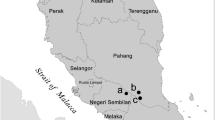Abstract
There are potentially many situations in which creatures will be subject to infrequent but regular culling. In terms of controlling crop pests, some farmers may only be able to afford to apply pesticides occasionally. Alternatively, pesticides may be applied only occasionally to limit their unwelcome side effects, which include pesticide resistance, chemical poisoning of agricultural workers, and environmental degradation. In terms of conservation, some species (such as the red deer in the UK) may be culled occasionally to maintain balances within their ecosystem. However, in this paper we discover, as the culmination of an exploration of adult-stage culling of a creature with juvenile and adult life stages, that, in certain circumstances, regular but infrequent culling will, perversely, increase the average population of the creature.
Similar content being viewed by others
References
Bolter, C.J., Dickel, M., van Loon, J.J.A., Visser, J.H., Posthumus, M.A., 1997. Attraction of Colorado Potato Beetle to herbivore-damaged plants during herbivory and after its termination. J. Chem. Ecol. 23(4), 1003–1023.
Choisy, M., Guegán, J.-F., Rohani, P., 2006. Dynamics of infectious diseases and pulse vaccination: Teasing apart the embedded resonance effects. Physica D 223, 26–35.
Cooke, K., van den Driessche, P., Zou, X., 1999. Interaction of maturation delay and nonlinear birth in population and epidemic models. J. Math. Biol. 39, 332–352.
Deimling, K., 1985. Nonlinear Functional Analysis. Springer, Berlin.
Dixon, A.F.G., 1998. Aphid Ecology: An Optimization Approach. Chapman and Hall, London.
Donnelly, C.A., Woodroffe, R., Cox, D.R., Bourne, F.J., Cheeseman, C.L., Clifton-Hadley, R.S., Weil, G., Gettinby, G., Gilks, P., Jenkins, H., Johnston, W.T., Le Fevrel, A.M., McInerney, J.P., Morrison, W.I., 2006. Positive and negative effects of widespread badger culling on tuberculosis in cattle. Nature 439, 843–846.
East, I.J., Eisemann, C.H., 1993. Vaccination against Lucilia cuprina: The causative agent of sheep blowfly strike. Immunol. Cell Biol. 71, 453–462.
Epstein, P.R., 2000. Is global warming harmful to health? Sci. Am. 283, 50–57.
Gourley, S.A., Liu, R., Wu, J., 2007. Eradicating vector-borne diseases via age-structured culling. J. Math. Biol. 54(3), 309–335.
Gubler, D.J., 1998. Resurgent vector-borne diseases as a global health problem. Emerg. Infect. Dis. 4(3), 442–450.
Gurney, W., Blythe, S., Nisbet, R., 1980. Nicholson’s blowflies revisited. Nature 287, 17–21.
Kuang, Y., 1993. Delay Differential Equations with Applications in Population Dynamics. Academic Press, San Diego.
Lacey, L.A., Frutos, R., Kaya, H.K., Vail, P., 2001. Insect pathogens as biological control agents: do they have a future? Biol. Control 21, 230–248.
Miller, G.T., 2004. Sustaining the Earth, 6th edn. Thompson Learning, Pacific Grove.
Nicholson, A.J., 1954. An outline of the dynamics of animal populations. Aust. J. Zoology 2, 9–65.
Nicholson, A.J., 1957. The self-adjustment of populations to change. Cold Spring Harbour Symp. Quant. Biol. 22, 153–173.
Phillips, B.L., Brown, G.P., Shine, R., 2003. Assessing the potential impact of cane toads on Australian snakes. Conserv. Biol. 17(6), 1738–1747.
Phillips, B.L., Brown, G.P., Webb, J.K., Shine, R., 2006. Invasion and the evolution of speed in toads. Nature 439, 803.
Ricker, W.E., 1954. Stock and recruitment. J. Fish. Res. Board Can. 11, 559–623.
Ricker, W.E., 1958. Handbook of computations for biological statistics of fish populations. Bull. Fish. Res. Board Can. 119, 1–300.
Seok Kim, K., Sappington, T.W., 2004. Boll Weevil (Anthonomus grandis Boheman) (Coleoptera: Curculionidae) dispersal in the Southern United States: evidence from mitochondrial DNA variation. Environ. Entomol. 33(2), 457–470.
Shulgin, B., Stone, L., Agur, Z., 1998. Pulse vaccination strategy in the SIR epidemic model. Bull. Math. Biol. 60, 1123–1148.
Simons, R.R.L., Gourley, S.A., 2006. Extinction criteria in stage-structured population models with impulsive culling. SIAM J. Appl. Math. 66(6), 1853–1870.
Smith, H.L., 1995. Monotone Dynamical Systems: An Introduction to the Theory of Competitive and Cooperative Systems. American Mathematical Society, Providence.
Terry, A.J., 2010. Impulsive adult culling of a tropical pest with a stage-structured life cycle. Nonlinear Anal. Real World Appl. 11(2), 645–664.
Thieme, H.R., 2003. Mathematics in Population Biology. Princeton Series in Theoretical and Computational Biology. Princeton University Press, Princeton.
Trenkel, V.M., 2001. Exploring red deer culling strategies using a population-specific calibrated management model. J. Environ. Manag. 621, 37–53.
van Aarde, R., Whyte, I., Pimm, S., 1999. Culling and the dynamics of the Kruger National Park African elephant population. Anim. Conserv. 2, 287–294.
Witzgall, P., Stelinski, L., Gut, L., Thomson, D., 2008. Codling moth management and chemical ecology. Ann. Rev. Entomol. 53, 503–522.
World Health Organization Press Release (2/11/2000). Pulse Polio Campaign Targets over 107 Million Children in 11 States, http://www.searo.who.int/EN/Section316/Section503/Section2373_12973.htm.
Zhao, X.-Q., 2003. Dynamical Systems in Population Biology. CMS Books in Mathematics. Springer, New York.
Author information
Authors and Affiliations
Corresponding author
Rights and permissions
About this article
Cite this article
Terry, A.J., Gourley, S.A. Perverse Consequences of Infrequently Culling a Pest. Bull. Math. Biol. 72, 1666–1695 (2010). https://doi.org/10.1007/s11538-009-9492-9
Received:
Accepted:
Published:
Issue Date:
DOI: https://doi.org/10.1007/s11538-009-9492-9




